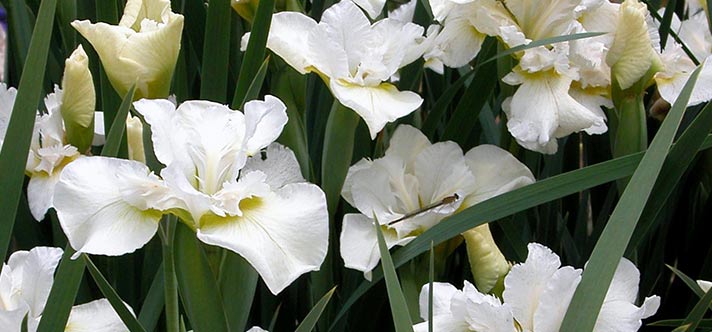How to grow Irises
Planting

When ? : during summer.
Between July and mid-October as soon as you receive your rhizomes. It is necessary that the roots of newly planted Irises are well established before winter.
Where ? : in full sun.
Irises need sun at least two thirds of the day. The soil must have very good drainage. Plant either on a slope or in raised beds. No water should be allowed to stand in iris beds.
Soil preparation
If your soil is heavy, coarse sand or humus may be added to improve drainage. Lime is also good to improve clay soils. The ideal pH is 7 (neutral), but irises are tolerant in this regard. Remove all the weeds before planting.
Distance apart
Irises are generally planted 30 to 40 cm apart. Close planting gives an immediate effect, but the irises will need to be thinned often.
Depth to plant
Irises must be planted so that the tops of the rhizomes are exposed and the roots are spread out facing downward in the soil. Just after planting, water to pack down the soil around the roots.

General care
Watering
Newly set plants need moisture to help their root system become established. Once established, irises do not need to be watered except in arid areas and it is always better to under-water than over-water.
TOO MUCH WATER CAN INDUCE ROT.
Dividing old clumps
Irises must be divided every 3,4 or 5 years before they become overcrowded and begin to flower less. You must also divide them because some varieties can choke others and disease problems can be aggravated. Old clumps can be thinned by removing the old divisions at the centres of the clumps and leaving new growth in the ground. Alternatively, dig up the entire clump and remove and replant the big new rhizomes. This should be done in July.
Feeding
Types of fertilizer depend on your type of soil but bone meal, superphosphate or 5-10-15, or 6-8-12 are effective. Feed once in early spring and then one month after flowering.
AVOID USING FERTILIZERS HIGH IN NITROGEN: IT ENCOURAGES ROT PROBLEMS.
About the foliage
During the growing season healthy green leaves should be left undisturbed, but diseased or brown leaves must be removed. In the late autumn, trim off old dying foliage and cut the leaves back to about 15 cm. Flower stems should be cut off close to the ground after blooming.
Disease of iris
Leaf spot
This common fungal disease appears with wet conditions. Yellow and brown spots appear near the tops of the leaves and may spread downward. Cut off and destroy the most affected leaves. You can also spray with a fungicide in April and then every 4 weeks till end of June (but do not use always the same chemical).
Root rot
This often appears first at the base of the leaves near the rhizome and is manifested by a yellowing of the fans. The soft mushy tissue must be removed with an old spoon or a knife and then you have to disinfect the wounds made to the rhizome (with sulfur or 10% bleach solution).
Diseases due to insects
Aphids and thrips can damage iris and spread diseases. Control them by spraying with an insecticide.

